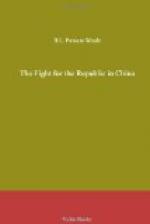3. Great Britain and Tibet to negotiate, independent of China, new trade regulations.
4. No Chinese officials and troops to be stationed in Tibet.
5. China to recognize Dalai Lama as the head of the Buddhist Religion and institutions in Mongolia and China.
6. China to compensate Tibet for forcible exactions of money or property taken from the Tibetan Government.
The Chinese Plenipotentiary made the following counter-proposals:—
1. Tibet forms an integral part of Chinese territory and Chinese rights of every description which have existed in consequence of this integrity shall be respected by Tibet and recognized by Great Britan. China engages not to convert Tibet into a province and Great Britain not to annex Tibet or any portion of it.
2. China to appoint a Resident at Lhassa with an escort of 3,600 soldiers.
3. Tibet undertakes to be guided by China in her foreign and military affairs and not to enter into negotiations with any foreign Power except through the intermediary of China but this engagement does not exclude direct relations between British Trade Agents and Tibetan authorities as provided in the Anglo-Chinese Convention of 1906.
4. Tibet to grant amnesty to those Tibetans known for their pro-Chinese inclinations and to restore to them their property.
5. Clause 5 of Tibetan claims can be discussed.
6. Revision of Trade Regulations of 1893 and 1908, if found necessary, must be made by all the parties concerned.
7. In regard to the limits of Tibet China claims Giamda and all the places east of it.
THE BOUNDARY DEADLOCK
The British plenipotentiary sustained in the main the Tibetan view concerning the limits of Tibet. He suggested the creation of Inner and Outer Tibet by a line drawn along the Kuenlun Range to the 9eth longitude, turning south reaching a point south of the 34th latitude, then in south-easterly direction to Niarong, passing Hokow, Litang, Batang in a western and then southern and southwestern direction to Rima, thus involving the inclusion of Chiamdo in Outer Tibet and the withdrawal of the Chinese garrison stationed there. He proposed that recognition should be accorded to the autonomy of Outer Tibet whilst admitting the right of the Chinese to re-establish such a measure of control in Inner Tibet as would restore and safeguard their historic position there, without in any way infringing the integrity of Tibet as a geographical and political entity. Sir Henry McMahon also submitted to the Conference a draft proposal of the Convention to the plenipotentiaries. After some modification this draft was initialled by the British and Tibetan delegates but the Chinese delegate did not consider himself authorized to do so. Thereupon the British member after making slight concessions in regard to representation in the Chinese Parliament




